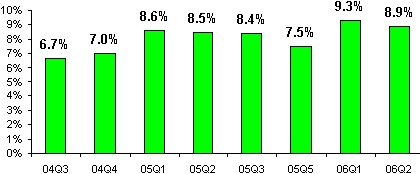IDEX Online Research: India’s Economic Growth Outpaces Expectations
October 12, 06
All cylinders are firing in the economy of India, one of the major jewelry producing and consuming regions of the world. Second quarter Gross Domestic Product (GDP), the measure of all the goods and services produced in a geopolitical area, rose by a sharp 8.9 percent, well above consensus expectations of about 8.5 percent. With the twelfth largest economy in the world, India’s annual output represents about 1.6 percent of global GDP, a percentage that is rising rapidly.
All three key sectors of the economy – services, manufacturing, and farm output – posted solid gains. Based on current trends, it is likely that the economy of India will grow by at least 8.5-9.0 percent for the twelve months ended December 2006. The graph below summarizes India’s real GDP growth for the past eight quarters.
India – Real GDP Growth Source: India Government
By Quarter
The second quarter growth of GDP – +8.9 percent – was slightly below the dramatic growth pace of 9.3 percent in the first quarter; this slight retraction was due to a modest cooling in India’s service sector, which is due for a cyclical pause while it catches its breath to prepare for the next growth spurt.
Meanwhile, India’s domestic market-oriented manufacturing sector grew at breakneck speed, accelerating from the pace set in the first quarter. In the farm sector, growth was solid. Agriculture provides the principal source of income for about two-thirds of India’s 1.1 billion people, so strong farm output supports consumer spending.
Outlook Bright
With its huge population experiencing rising disposable personal incomes, we expect to see further strength in India’s manufacturing sector, which produces most of the goods consumed by the country’s shoppers.
Longer term, however, India’s economic growth continues to experience significant headwinds. For example, the dismal state of India’s domestic infrastructure has severely restricted the development of large-scale production facilities. Transportation and energy are in abysmal shape. Further, Indian policymakers have been too slow to remove the archaic restrictions on foreign investment for many industrial sectors. Robust growth in the industrial sector is needed to generate employment growth to accommodate the ever-increasing number of workers moving to urban areas in search of higher paying jobs.
Despite these ongoing structural imbalances, India’s economic fundamentals remain sound, and prospects for the economy are positive. Higher interest rates could take some of the wind out of the sails of GDP growth in the second half of 2006, but that will not keep India’s economy from stalling. In short, the resilience of the elephant economy is amazing.